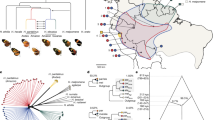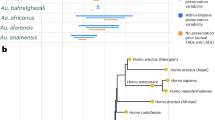Abstract
Anticipating species’ responses to environmental change is a pressing mission in biodiversity conservation. Despite decades of research investigating how climate change may affect population sizes, historical context is lacking, and the traits that mediate demographic sensitivity to changing climate remain elusive. We use whole-genome sequence data to reconstruct the demographic histories of 263 bird species over the past million years and identify networks of interacting morphological and life history traits associated with changes in effective population size (Ne) in response to climate warming and cooling. Our results identify direct and indirect effects of key traits representing dispersal, reproduction and survival on long-term demographic responses to climate change, thereby highlighting traits most likely to influence population responses to ongoing climate warming.
This is a preview of subscription content, access via your institution
Access options
Access Nature and 54 other Nature Portfolio journals
Get Nature+, our best-value online-access subscription
$29.99 / 30 days
cancel any time
Subscribe to this journal
Receive 12 digital issues and online access to articles
$119.00 per year
only $9.92 per issue
Buy this article
- Purchase on Springer Link
- Instant access to full article PDF
Prices may be subject to local taxes which are calculated during checkout




Similar content being viewed by others
Data availability
All data underlying these analyses (including raw Ne estimates over time for each species) are available in the Dryad Digital Repository38.
Code availability
All code underlying these analyses is available in the Dryad Digital Repository38.
References
Butchart, S. H. M. et al. Global biodiversity: indicators of recent declines. Science. 328, 1164–1168 (2010).
Dirzo, R. et al. Defaunation in the Anthropocene. Science. 345, 401–406 (2014).
Intergovernmental Science-Policy Platform on Biodiversity and Ecosystem Services (IPBES). Global Assessment Report on Biodiversity and Ecosystem Services (IPBES secretariat, 2019).
Rosenberg, K. V. et al. Decline of the North American avifauna. Science. 366, 120–124 (2019).
Fordham, D. A. et al. Using paleo-archives to safeguard biodiversity under climate change. Science. 369, eabc5654 (2020).
Nogués-Bravo, D. et al. Cracking the code of biodiversity responses to past climate change. Trends Ecol. Evol. 33, 765–776 (2018).
Foden, W. B. et al. Climate change vulnerability assessment of species. WIREs Clim. Change. 10, e551 (2019).
Chattopadhyay, B., Garg, K. M., Ray, R. & Rheindt, F. E. Fluctuating fortunes: genomes and habitat reconstructions reveal global climate-mediated changes in bats’ genetic diversity. Proc. R. Soc. B. 286, 20190304 (2019).
Chen, L. et al. Large-scale ruminant genome sequencing provides insights into their evolution and distinct traits. Science. 364, eaav6202 (2019).
Peart, C. R. et al. Determinants of genetic variation across eco-evolutionary scales in pinnipeds. Nat. Ecol. Evol. 4, 1095–1104 (2020).
Jenouvrier, S. Impacts of climate change on avian populations. Glob. Change Biol. 19, 2036–2057 (2013).
Pacifici, M. et al. Species’ traits influenced their response to recent climate change. Nat. Clim. Change. 7, 205–208 (2017).
Foden, W. B. et al. Identifying the world’s most climate change vulnerable species: a systematic trait-based assessment of all birds, amphibians and corals. PLoS ONE. 8, e65427 (2013).
Telenský, T., Klvaňa, P., Jelínek, M., Cepák, J. & Reif, J. The influence of climate variability on demographic rates of avian Afro-palearctic migrants. Sci. Rep. 10, 17592 (2020).
Jiguet, F., Gadot, A.-S., Julliard, R., Newson, S. E. & Couvet, D. Climate envelope, life history traits and the resilience of birds facing global change. Glob. Change Biol. 13, 1672–1684 (2007).
Lorenzen, E. D. et al. Species-specific responses of Late Quaternary megafauna to climate and humans. Nature. 479, 359–364 (2011).
Hung, C.-M. et al. Drastic population fluctuations explain the rapid extinction of the passenger pigeon. Proc. Natl. Acad. Sci. USA. 111, 10636–10641 (2014).
Feng, S. et al. The genomic footprints of the fall and recovery of the crested ibis. Curr. Biol. 29, 340–349.e7 (2019).
Feng, S. et al. Dense sampling of bird diversity increases power of comparative genomics. Nature. 587, 252–257 (2020).
Li, H. & Durbin, R. Inference of human population history from individual whole-genome sequences. Nature. 475, 493–496 (2011).
Fjeldså, J., Christidis, L. & Ericson, P. G. P. (eds) The Largest Avian Radiation: The Evolution of Perching Birds, or the Order Passeriformes (Lynx Edicions, 2020).
Bay, R. A. et al. Genomic signals of selection predict climate-driven population declines in a migratory bird. Science. 359, 83–86 (2018).
Parmesan, C. Ecological and evolutionary responses to recent climate change. Annu. Rev. Ecol. Evol. Syst. 37, 637–669 (2006).
Angert, A. L. et al. Do species’ traits predict recent shifts at expanding range edges? Ecol. Lett. 14, 677–689 (2011).
McCain, C. M. & King, S. R. B. Body size and activity times mediate mammalian responses to climate change. Glob. Change Biol. 20, 1760–1769 (2014).
Barrett, R. D. H. & Schluter, D. Adaptation from standing genetic variation. Trends Ecol. Evol. 23, 38–44 (2008).
Hancock, A. M. et al. Adaptation to climate across the Arabidopsis thaliana genome. Science. 334, 83–86 (2011).
McKenna, A. et al. The Genome Analysis Toolkit: a MapReduce framework for analyzing next-generation DNA sequencing data. Genome Res. 20, 1297–1303 (2010).
Nadachowska-Brzyska, K., Li, C., Smeds, L., Zhang, G. & Ellegren, H. Temporal dynamics of avian populations during pleistocene revealed by whole-genome sequences. Curr. Biol. 25, 1375–1380 (2015).
Jarvis, E. D. et al. Whole-genome analyses resolve early branches in the tree of life of modern birds. Science. 346, 1320–1331 (2014).
Rokas, A., Williams, B. L., King, N. & Carroll, S. B. Genome-scale approaches to resolving incongruence in molecular phylogenies. Nature. 425, 798–804 (2003).
Wolf, Y. I., Rogozin, I. B., Grishin, N. V. & Koonin, E. V. Genome trees and the tree of life. Trends Genet. 18, 472–479 (2002).
Yang, Z. PAML: a program package for phylogenetic analysis by maximum likelihood. Comput. Appl. Biosci. 13, 555–556 (1997).
Forest, F. Calibrating the tree of life: fossils, molecules and evolutionary timescales. Ann. Bot. 104, 789–794 (2009).
Magallón, S. A. Dating lineages: molecular and paleontological approaches to the temporal framework of clades. Int. J. Plant Sci. 165, S7–S21 (2004).
Nadachowska-Brzyska, K., Burri, R., Smeds, L. & Ellegren, H. PSMC analysis of effective population sizes in molecular ecology and its application to black-and-white Ficedula flycatchers. Mol. Ecol. 25, 1058–1072 (2016).
Bird, J. P. et al. Generation lengths of the world’s birds and their implications for extinction risk. Cons. Biol. 34, 1252–1261 (2020).
Germain, R. et al. Species-specific traits mediate avian demographic responses under past climate change. Preprint at http://datadryad.org/stash/dataset/doi:10.5061/dryad.fn2z34tz8 (2022).
Patton, A. H. et al. Contemporary demographic reconstruction methods are robust to genome assembly quality: a case study in Tasmanian devils. Mol. Biol. Evol. 36, 2906–2921 (2019).
Liu, X. & Fu, Y.-X. Exploring population size changes using SNP frequency spectra. Nat. Genet. 47, 555–559 (2015).
Terhorst, J. & Song, Y. S. Fundamental limits on the accuracy of demographic inference based on the sample frequency spectrum. Proc. Natl Acad. Sci. USA 112, 7677–7682 (2015).
Terhorst, J., Kamm, J. A. & Song, Y. S. Robust and scalable inference of population history from hundreds of unphased whole genomes. Nat. Genet. 49, 303–309 (2017).
Lapierre, M., Lambert, A. & Achaz, G. Accuracy of demographic inferences from the site frequency spectrum: the case of the yoruba population. Genetics. 206, 439–449 (2017).
Mazet, O., Rodríguez, W., Grusea, S., Boitard, S. & Chikhi, L. On the importance of being structured: instantaneous coalescence rates and human evolution—lessons for ancestral population size inference? Heredity. 116, 362–371 (2016).
Chikhi, L. et al. The IICR (inverse instantaneous coalescence rate) as a summary of genomic diversity: insights into demographic inference and model choice. Heredity. 120, 13–24 (2018).
Teixeira, H. et al. Impact of model assumptions on demographic inferences: the case study of two sympatric mouse lemurs in northwestern Madagascar. BMC Ecol. Evol. 21, 197 (2021).
Galili, T. dendextend: an R package for visualizing, adjusting and comparing trees of hierarchical clustering. Bioinformatics. 31, 3718–3720 (2015).
Smith, M. R. TreeDist: distances between phylogenetic trees. Zenodo https://doi.org/10.5281/ZENODO.3528124 (2019).
Paleo-López, R. et al. A phylogenetic analysis of macroevolutionary patterns in fermentative yeasts. Ecol. Evol. 6, 3851–3861 (2016).
Snyder, C. W. Evolution of global temperature over the past two million years. Nature. 538, 226–228 (2016).
David, F. N. Tables of the Ordinates and Probability Integral of the Distribution of the Correlation Coefficient in Small Samples (Cambridge Univ. Press, 1938).
Guenther, W. C. Desk calculation of probabilities for the distribution of the sample correlation coefficient. Am. Stat. 31, 45–48 (1977).
Bates, D., Mächler, M., Bolker, B. & Walker, S. Fitting linear mixed-effects models using lme4. J. Stat. Softw. 67, 1–48 (2015).
Barton, K. MuMIn: multi-model inference. R (2022).
White, G. & Burnham, K. Program MARK: survival estimation from populations of marked animals. Bird Study. 46, 120–139 (1999).
Nakagawa, S. & Schielzeth, H. A general and simple method for obtaining R2 from generalized linear mixed-effects models. Methods Ecol. Evol. 4, 133–142 (2013).
van der Bijl, W. phylopath: perform phylogenetic path analysis. R (2021).
Gonzalez-Voyer, A. & von Hardenberg, A. in Modern Phylogenetic Comparative Methods and Their Application in Evolutionary Biology (ed Garamszegi, L.), pp 201–229 (Springer, 2014).
Holt, B. G. et al. An update of Wallace’s zoogeographic regions of the world. Science. 339, 74–78 (2013).
Acknowledgements
This work was made possible by the generous efforts of field biologists and museum staff who contributed samples to the B10k Project. This work was supported by a National Natural Science Foundation of China grant (nos. 32170626 and 31901214) to S.F., an Independent Research Fund Denmark grant to D.N.-B. and G.Z. (no. 8021-00282B) and grants from the Strategic Priority Research Program of the Chinese Academy of Sciences (no. XDB31020000), International Partnership Program of the Chinese Academy of Sciences (no. 152453KYSB20170002), Carlsberg Foundation (no. CF16-0663) and Villum Foundation (no. 25900) to G.Z.
Author information
Authors and Affiliations
Contributions
R.R.G., S.F., G.Z. and D.N-B. designed the study and wrote the paper. R.R.G., S.F. and G.C. carried out analyses. R.R.G., S.F., G.C., G.R.G., J.A.T., C.R., F.L., J.F., P.A.H., M.T.P.G., G.Z. and D.N-B. contributed towards the assembly of genomic and morphological and life history data, discussion of results and reviewing and editing the manuscript.
Corresponding authors
Ethics declarations
Competing interests
The authors declare no competing interests.
Peer review
Peer review information
Nature Ecology & Evolution thanks Nicolas Dussex and the other, anonymous, reviewer(s) for their contribution to the peer review of this work.
Additional information
Publisher’s note Springer Nature remains neutral with regard to jurisdictional claims in published maps and institutional affiliations.
Supplementary information
Supplementary Information
Supplementary Notes 1–3, Tables 1–12, Figs. 1–24 and additional references.
Rights and permissions
Springer Nature or its licensor (e.g. a society or other partner) holds exclusive rights to this article under a publishing agreement with the author(s) or other rightsholder(s); author self-archiving of the accepted manuscript version of this article is solely governed by the terms of such publishing agreement and applicable law.
About this article
Cite this article
Germain, R.R., Feng, S., Chen, G. et al. Species-specific traits mediate avian demographic responses under past climate change. Nat Ecol Evol 7, 862–872 (2023). https://doi.org/10.1038/s41559-023-02055-3
Received:
Accepted:
Published:
Issue Date:
DOI: https://doi.org/10.1038/s41559-023-02055-3



